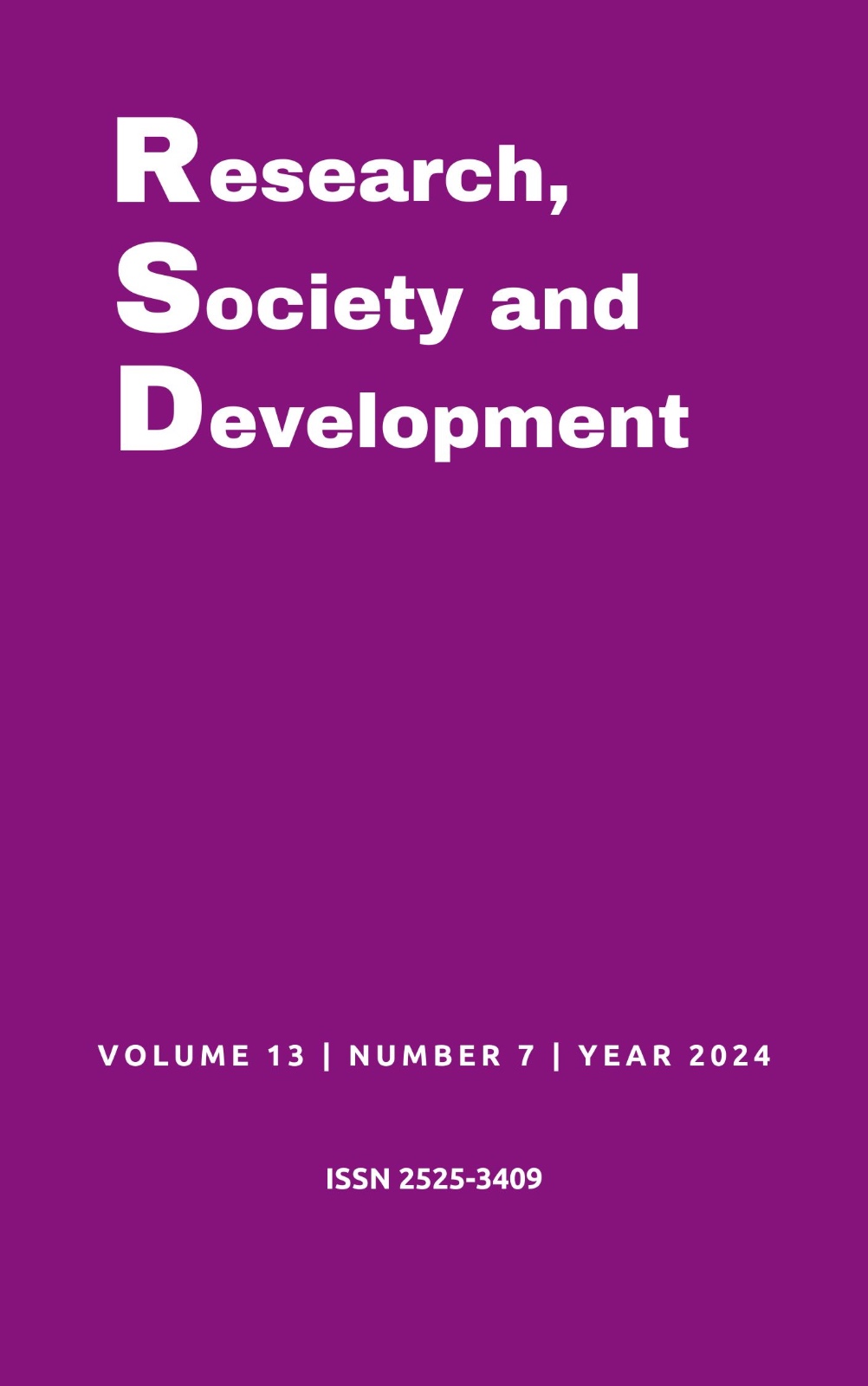Prospective analysis of the antiepileptic potential of species from the Passifloraceae, Zingiberaceae and Cannabaceae families
DOI:
https://doi.org/10.33448/rsd-v13i7.45760Keywords:
Epilepsy, Pharmacology, Natural products.Abstract
Epilepsy is a chronic neurological condition characterized by recurrent seizures and without a definitive cure, significantly impacting patients' quality of life. Conventional treatment involves the use of antiepileptic drugs, which, although effective in controlling seizures, can cause a series of harmful side effects and do not address the underlying cause of the disease. Additionally, patients with drug-resistant epilepsy face additional challenges, including cognitive impairment and low educational and occupational performance. In this context, researching new treatment alternatives for epilepsy becomes crucial. A promising area is the study of natural extracts from medicinal plants, which have been investigated for their antiepileptic potential. This study focuses on the Passifloraceae, Zingiberaceae, and Cannabaceae families due to their richness in bioactive compounds with pharmacological properties. Scientific research has revealed that several species from these plant families possess antiepileptic and anticonvulsant activities, providing a basis for the development of new treatments. However, the challenges faced in obtaining patents and developing herbal products in Brazil highlight the need for additional investments and clear regulatory policies in this area. Therefore, continuous research on the therapeutic potential of medicinal plants, along with efforts to improve access to innovative treatments, is essential to enhance epilepsy management and patients' quality of life.
References
Ballester, P., Cerdá, B., Arcusa, R., García-Muñoz, A. M., Marhuenda, J., & Zafrilla, P. (2023). Antioxidant Activity in Extracts from Zingiberaceae Family: Cardamom, Turmeric, and Ginger. Molecules (Basel, Switzerland), 28(10), 4024. https://doi.org/10.3390/molecules28104024
Birhan Y. S. (2022). Medicinal plants utilized in the management of epilepsy in Ethiopia: ethnobotany, pharmacology and phytochemistry. Chinese medicine, 17(1), 129. https://doi.org/10.1186/s13020-022-00686-5
Burakgazi Dalkilic E. (2021). Effects of antiepileptic drugs on hormones. Neuroscience letters, 754, 135800. https://doi.org/10.1016/j.neulet.2021.135800
Carson, R., & Stredny, C. M. (2024). Severe, refractory seizures. The Medical Clinics of North America, 108(1), 201–213. https://doi.org/10.1016/j.mcna.2023.05.020
Chu, H., Wang, B., Zhao, X., & Mu, L. (2024). Epilepsy and psychiatric comorbidities: A bidirectional mendelian randomization study. Journal of Affective Disorders, 350, 774–783. https://doi.org/10.1016/j.jad.2024.01.178
Fonseca, L. R., Rodrigues, R. A., Ramos, A. S., da Cruz, J. D., Ferreira, J. L. P., Silva, J. R. A., & Amaral, A. C. F. (2020). Herbal Medicinal Products from Passiflora for Anxiety: An Unexploited Potential. TheScientificWorldJournal, 2020, 6598434. https://doi.org/10.1155/2020/6598434
Fotsing, S. I., Ngo Pambe, J. C., Silihe, K. K., Yembeau, N. L., Choupo, A., Njamen, D., Pieme, C. A., & Zingue, S. (2023). Breast cancer cell growth arrest and chemopreventive effects of Passiflora edulis Sims (Passifloraceae) ethanolic leaves extract on a rat model of mammary carcinoma. Journal of Ethnopharmacology, 311(116408), 116408. https://doi.org/10.1016/j.jep.2023.116408.
Hasenclever, L., Paranhos, J., Costa, C. R., Cunha, G., & Vieira, D. (2017). A indústria de fitoterápicos brasileira: desafios e oportunidades. Ciencia & saude coletiva, 22(8), 2559–2569. https://doi.org/10.1590/1413-81232017228.29422016
Huang, Y.-Y. (2020). “medicine of the grassroots”: Korean herbal medicine industry and consumption during the Japanese colonial period. Korean Journal of Medical History, 29(1), 215–274. https://doi.org/10.13081/kjmh.2020.29.215
Jafarpour, S., Hirsch, L. J., Gaínza-Lein, M., Kellinghaus, C., & Detyniecki, K. (2019). Seizure cluster: Definition, prevalence, consequences, and management. Seizure, 68, 9–15. https://doi.org/10.1016/j.seizure.2018.05.013
Janda, K., Wojtkowska, K., Jakubczyk, K., Antoniewicz, J., & Skonieczna-Żydecka, K. (2020). Passiflora incarnata in Neuropsychiatric Disorders—A Systematic Review. Nutrients, 12(12), 3894. https://doi.org/10.3390/nu12123894
Lu, H. C., & Mackie, K. (2021). Review of the Endocannabinoid System. Biological psychiatry. Cognitive neuroscience and neuroimaging, 6(6), 607–615. https://doi.org/10.1016/j.bpsc.2020.07.016
Manford M. (2017). Recent advances in epilepsy. Journal of neurology, 264(8), 1811–1824. https://doi.org/10.1007/s00415-017-8394-2
Miziak, B., Konarzewska, A., Ułamek-Kozioł, M., Dudra-Jastrzębska, M., Pluta, R., & Czuczwar, S. J. (2020). Anti-Epileptogenic Effects of Antiepileptic Drugs. International journal of molecular sciences, 21(7), 2340. https://doi.org/10.3390/ijms21072340
Neri, S., Mastroianni, G., Gardella, E., Aguglia, U., & Rubboli, G. (2022). Epilepsy in neurodegenerative diseases. Epileptic Disorders: International Epilepsy Journal with Videotape, 24(2), 249–273. https://doi.org/10.1684/epd.2021.1406
Oliveira, J. F. de, Costa, A. G. de J., Costa, A. C. S. de M., Santana, L. S., Sousa, D. S., & Aquino, M. J. das V. (2023). Prospecção científica e tecnológica sobre uso da Cannabis sativa (Cânhamo) em pacientes neuropatas ou com distúrbios neuropsiquiátricos. Research, Society and Development, 12(2), e5112236990. https://doi.org/10.33448/rsd-v12i2.36990.
Razak, A. M., Tan, J. K., Mohd Said, M., & Makpol, S. (2023). Modulating Effects of Zingiberaceae Phenolic Compounds on Neurotrophic Factors and Their Potential as Neuroprotectants in Brain Disorders and Age-Associated Neurodegenerative Disorders: A Review. Nutrients, 15(11), 2564. https://doi.org/10.3390/nu15112564
Sommano, S. R., Chittasupho, C., Ruksiriwanich, W., & Jantrawut, P. (2020). The Cannabis Terpenes. Molecules (Basel, Switzerland), 25(24), 5792. https://doi.org/10.3390/molecules25245792
Zhang, X., Deng, J., Tang, Y., Guan, X., Chen, X., & Fan, J. (2022). Zingiberaceae plants/curcumin consumption and multiple health outcomes: An umbrella review of systematic reviews and meta‐analyses of randomized controlled trials in humans. Phytotherapy Research: PTR, 36(8), 3080–3101. https://doi.org/10.1002/ptr.7500.
Downloads
Published
Issue
Section
License
Copyright (c) 2024 Jackeline Almeida Fonseca; Tarcísio Batista Santos; Marina Maria de Melo Santana Andrade; Licia Santos Santana; Maria Jane das Virgens Aquino; Davi Santana Sousa; Aida Carla Santana de Melo Costa

This work is licensed under a Creative Commons Attribution 4.0 International License.
Authors who publish with this journal agree to the following terms:
1) Authors retain copyright and grant the journal right of first publication with the work simultaneously licensed under a Creative Commons Attribution License that allows others to share the work with an acknowledgement of the work's authorship and initial publication in this journal.
2) Authors are able to enter into separate, additional contractual arrangements for the non-exclusive distribution of the journal's published version of the work (e.g., post it to an institutional repository or publish it in a book), with an acknowledgement of its initial publication in this journal.
3) Authors are permitted and encouraged to post their work online (e.g., in institutional repositories or on their website) prior to and during the submission process, as it can lead to productive exchanges, as well as earlier and greater citation of published work.


